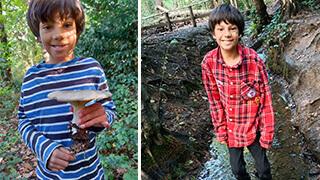breadcrumb navigation:
- Home /
- Research /
- Family stories /
-
current page
Robi: CDA-1 anaemia
Robi: CDA-1 anaemia
Published on
Updated:

Robi's Story
CDA-1 anaemia
A shortage of these important cells prevents their blood from transporting enough oxygen around their body. The condition is usually diagnosed in childhood and can seriously affect a child’s everyday life.[1]
Robi received regular blood transfusions from birth as he had low levels of haemoglobin – the substance which transports oxygen around your body.[2] At nine months old, doctors decided to take a bone marrow biopsy and the results confirmed that he has CDA-1. Once doctors understood what Robi’s condition was, he started on alpha-interferon therapy to boost his haemoglobin levels.[3]
Robi's mum Resina describes her son as a very happy little boy who participates in sports and enjoys school. In addition to CDA-1, he has dyspraxia and dyslexia and receives additional support with his schooling. “Robi has an education, health and care plan and receives excellent support at school which has benefited him greatly,” Resina says. “As far as we’re aware, Robi’s dyslexia and dyspraxia are not directly linked to CDA-1, but because his blood is generally less oxygenated, this can impact a child’s general development,” she adds.
“Robi experiences stomach pains which might be linked to his CDA-1 – he’s been recommended to have a liver scan to look into this,” says Resina. “Robi also has issues with his fine motor skills which are linked to his dyspraxia, and he has mild finger and toe deformities. The issues are not noticeable – for instance, he struggles with things like buttons and doing up his coat.”

“Looking at Robi you wouldn’t know that he has a rare condition – except possibly that he is very small for his age,” says Resina. “His confidence has really blossomed. There were concerns when he was younger and barely spoke at school, even though at home he was bright and bubbly he lacked confidence in social settings. This has really developed in recent years though.”
“He goes to a brilliant primary school where the teachers are very nurturing and aware of his needs. In terms of his physical activity, I think that the way sport is taught in school is less competitive nowadays – this enables children who are not physically active to enjoy physical education,” says Resina.
Action Medical Research funded a research project led by Dr Christian Babbs which aimed to improve diagnosis and treatment of this rare type of anaemia. This project finished in 2024 and has given important new insights into the underlying biology of CDA-1.
Resina is an advocate for the CDA-1 community and was delighted to hear about the positive results of Dr Babbs’ research. “This will have resulted in a better understanding of a very rare condition, and we are very grateful for the researchers in taking the time to learn more about CDA-1 and how it may be treated,” she says. “The fact that this research could lead to new and improved treatment gives us a lot of hope and could have a positive impact for Robi.”
“We are absolutely delighted that the research has been able to identify biomarkers for diagnosing CDA-1, meaning that the more intrusive bone marrow biopsy may no longer need to be used. This will cause less disruption in the lives of those affected by the condition and their carers. Robi was only nine months old when he had the biopsy, and it was obviously a stressful experience for him as he didn't understand what was happening.”
References
- Congenital dyserythropoietic anemia type 1. Genetic and Rare Diseases Information Centre. Available at: https://rarediseases.info.nih.gov/diseases/2000/congenital-dyserythropoietic-anemia-type-1. [Last accessed July 2022]
- NHS UK. Red blood cell count. Available at: https://www.nhs.uk/conditions/red-blood-count/. [Last accessed July 2022].
- Noémi B. A. Roy, and Christian Babbs. The pathogenesis, diagnosis and management of congenital dyserythropoietic anaemia type I, 2019.British Journal of Pharmacology, 185: (3) 436-449 https://doi.org/10.1111/bjh.15817.


